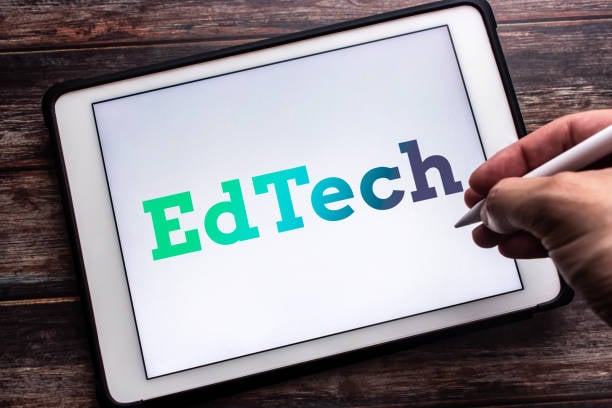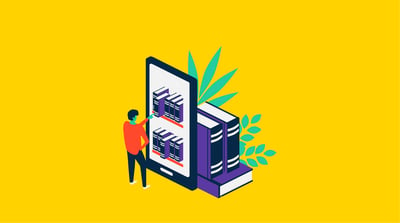March 25, 2022
 by Ben Hamilton / March 25, 2022
by Ben Hamilton / March 25, 2022

Technology has transformed the way we interact, and EdTech is no exception.
Educational technology, also known as EdTech, is no stranger. It grew faster than anyone could imagine and became a worldwide phenomenon within a few years. What started as a novelty or luxury is now a household name, heard and used by billions of people around the world.
Gone are the days when students and teachers resorted to traditional chalkboard teaching and learning methods. EdTech has broadened the horizon, giving users the ability to engage in new and innovative ways while bridging the gap between academic and social learning.
EdTech is short for education technology. It employs IT tools to enrich education and enhance learning. Student management systems, learning management systems, educational podcasts, video conferencing software, and social media tools, study tools all fall under the broad umbrella of EdTech.
Almost two decades ago, EdTech wasn't what it is today. Its rapid development has completely changed the learner and teacher dynamic globally.
Before EdTech became popular, students physically attended school in a classroom with physical books and were tutored by a physically present teacher. Some institutions still prefer the “physically present” aspect of education and choose hybrid learning over virtual learning for professional development.
EdTech’s growth is quickly shifting focus from classroom-based learning to online learning. Mobile devices, laptops, and tablets have made virtual learning much more effortless. All you need to do now is go online and enjoy a feature-rich learning experience. And who doesn't want that?
EdTech simplifies complex work and makes everyday tasks interesting. Teachers no longer have to manually grade hundreds of test papers, enroll students in institutions, and laboriously sort assignments through disjointed systems. EdTech takes care of this and many other tasks through automated grading tools.
Some might say that classrooms haven't changed. Modern students just experience them a little differently.
Learning from home is now more synonymous with working from home. Both are driving a surge in EdTech usage around the world. In fact, the global EdTech and smart Classroom size reached around $99.50 billion in 2021 at a compound annual growth rate (CAGR) of 19.34%, increasing to $241.58 billion by 2026.
As global circumstances magnify EdTech, many see and reap its benefits. EdTech helps deliver education globally, reducing travel and other learning-related costs while bridging the geographic divide.
Teachers, learners, and institutions benefit financially and save significant time with EdTech software that simplifies internal and external processes. While many are happy about the cost savings, EdTech preserves the environment as more institutions adopt e-learning and upload course content online.
Additionally, technologies such as cell phones and the internet are affordable and accessible on the wallet. Billions of people around the world depend on them for their daily activities. And this dependency is paving the way for accessible and good e-learning.
Although online education doesn’t have a fixed target audience, the younger generations are generally more inclined to accept online learning. Gen Z, for example, grew up in a technology-driven world and developed a strong fondness for it.
Personalized, flexible, and affordable education with diverse learning tools and platforms is more of an expectation than a luxury. This has resulted in EdTech rising through the ranks and making education accessible to all.
EdTech will continue to accelerate as companies seek to use technology to bridge the gap created by unprecedented events. This new shift in focus is toward becoming more agile and functioning optimally without interference. As technology becomes key to business operations, there will be more needs and better governance, and cloud services and EdTech will only grow in the future.
Education involves the transmission and preservation of knowledge from one individual to another. EdTech impacts the entire educational transaction from start to finish. Not only does it affect or enhance learning, but it also solves many pain points for teachers and institutions alike.
EdTech is evolving into a necessity. It offers flexible educational solutions that bridge the global divide while being cost-effective, which further strengthens its reach and liking.
Some visible ways EdTech has transformed education:
EdTech is education available through technology. As long as someone has a device and a working internet connection, they can use EdTech.
While many institutions turn to learning management and student management systems to deliver training and improve their back-end processes’ efficiency, students turn to EdTech for online training and assessments.
Users can pay for free remote learning tools and systems or access paid self-learning platforms. Demographics are not a constraint for EdTech.
EdTech offers many tools and systems to help education providers deliver the right learning experience. Below are some common EdTech systems.
Learning management systems have developed rapidly following e-learning's advent and have become widespread and accepted by institutions and students worldwide. These systems include software applications for tracking, grading, managing, and delivering online educational courses.
Many education providers struggle to maintain quality standards and increase productivity due to manual processes. As many of these organizations adopt and adapt to the new norm of working from home (WFH), interactions, assignments, student enrollments, and the like are more difficult to oversee and manage through Excel spreadsheets and multiple systems.
Using a student management system brings these processes into one easy-to-use application, allowing staff to focus on high-value tasks.
Video conferencing applications are doing the rounds and becoming a significant EdTech resource. They help conduct meetings and deliver lectures or courses as they host remote and hybrid work or school environments.
EdTech entails different learning styles and guided methodology for remote learning. Let's take a look at some top EdTech trends transforming education.
Virtual educational experiences are at their peak, leading to a global surge in online education. As institutions and students recognize and enjoy the EdTech benefits, they move closer to a virtual learning experience.
Simply put, virtual education is a learning environment where teachers deliver coursework through various course management applications over the internet and other multimedia resources.
Virtual experiences connect students and teachers separated in time and space as everything is done online and conveniently in each individual's chosen environment. While effective, classroom learning has taken a step backward. As virtual experiences skyrocket, EdTech is on its way to even greater innovation.
Virtual experiences have fueled several microtrends, including video-based learning, microlearning, and social learning, to name a few.
Video-based learning is learning something new by watching a video online. This can be done anywhere, anytime, and is a big part of virtual experiences.
In your lifetime, you've probably subscribed to a channel, signed up for a class, or watched a random video on social media that taught you something. This is extremely popular in online and virtual learning.
The amount of information we’re exposed to daily increases as technology develops. In fact, we absorb five times as much information today as we did in 1986. The ever-increasing amount of content consumed over the internet reduces the attention span for each content type.
EdTech companies now deliver content to audiences online in bite-sized portions. Students don't need to commit to lengthy sessions, as short-term, focused sessions are more effective and popular.
Social learning involves using social media to learn. It has peaked in recent years, especially when working from home is the norm. Because humans are social creatures and social media is a way of connecting people, it plays an essential role in our lives. Universities and companies in various industries see this as a gold mine and seize the opportunity to use social media for better learning experiences.
Customer relationship management (CRM) systems have been around for a long time, and millions of organizations use them worldwide. The need to manage customer interactions, build relationships, streamline processes, and increase profitability is timeless, which means CRMs will always be a trending tool.
Many institutions fail to realize that generic CRMs aren’t the only option available. CRM customization is slowly evolving, providing institutions with numerous benefits, including comprehensive virtual learning features and tools. Institutions can choose a CRM to meet their expectations and needs when looking for industry-specific CRMs.
EdTech trends and tools have laid the groundwork for innovation, prompting many companies to adopt this technology and see success. Let's look at some examples of successful EdTech campaigns and how they're transforming education.
Gamification involves adding game-like mechanics to a non-gaming environment, such as a learning management system, a student management system, an education app, a website, and so on. Gamification software is a global phenomenon and highly effective in EdTech. The global educational gamification market reached $697.26 million in 2020 and is expected to grow at a CAGR of 29% between 2021 and 2027.
Grammarly, a cloud-based writing assistant that checks spelling, grammar, punctuation, clarity, engagement, and delivery errors, leverages gamification through a "Freemium" approach. It allows users to access some features for free, but users need to subscribe and pay for monthly or yearly subscriptions to unlock all other features.
Free trial online learning often enables this model to give learners a taste of what is to come. If they like the first lesson, registering and paying for the course would naturally be the next step.
Gamification also offers awards, which is a good way to motivate users. For example, at the end of an online course, just like learners would receive a physical star for good work, virtual awards in the form of certificates, stars, or similar are given to keep them engaged and motivated.
There is no escaping artificial intelligence (AI), not even in education. In addition to providing each student with a personalized learning experience based on preferences, AI has evolved rapidly over the years, simplifying different scoring activities like grading.
Gone are the days when teachers manually graded hundreds or even thousands of test and exam papers. AI capabilities allow auto-grading to score multiple-choice and fill-in-the-blank type questions automatically. And this is just the tip of the iceberg.
Automated grading is a tool built into learning management systems that many institutions use to enable instructors to grade exams, tests, and assignments quickly and automatically, leaving no room for human error. This is a trend common in higher education institutions where grading is a necessity.
The system is coded to learn the responses and recognize if an answer is right or wrong. This useful, time-saving, and accuracy-enhancing EdTech tool has caught institutions' attention and is loved and used by millions worldwide.
EdTech has expanded and taken over the educational landscape. Chalkboard lessons are a thing of the past, slowly moving from dormancy to extinction. As education continues to shed new light on dark spaces, EdTech fully illuminates these dark spaces and brings infinite light.
This mushrooming new way of teaching and learning is constantly evolving, with new trends emerging every day. We haven't seen the end yet and anticipate even better future EdTech developments.
An example of EdTech developments? Virtual classrooms. Learn more about these secure and robust online teaching and learning spaces for teachers and students to collaborate.
Ben Hamilton is the CEO & Co-Founder of Wisenet and Head of Education APAC at Adapt IT. Ben Hamilton boasts 25 years’ experience in technology with a particular focus on the education sector. Ben holds a BSc in Chemistry as well as a post-graduate degree in Business Management. He is highly skilled in various technology areas, including cloud computing, VMWare, SugarCRM, Identity Management, and more.
The AI in education market, valued at $2.5 billion in 2022, is projected to reach $88.2...
 by Sagar Joshi
by Sagar Joshi
The education industry is brimming with fierce competition, with colleges and universities...
 by Ben Hamilton
by Ben Hamilton
There’s an online version of just about everything.
 by Mary Clare Novak
by Mary Clare Novak
The AI in education market, valued at $2.5 billion in 2022, is projected to reach $88.2...
 by Sagar Joshi
by Sagar Joshi
The education industry is brimming with fierce competition, with colleges and universities...
 by Ben Hamilton
by Ben Hamilton


